Initially this guide displays common birds of all types that are flying right now in our area. Use the selectors below to view rare birds, view birds flying any time, restrict the output to a certain shape of bird, or search by name.
New Mexico is on the western edge of the Central Flyway which is one of the major migration pathways between north and south for birds traveling between breeding and wintering grounds along the Rocky Mountains. This has resulted in the state having an incredible diversity of birds with over 550 different species reported. A little more than half of this number are sighted annually on the Pajarito Plateau. Some of these birds are full-time residents, some migrate here for a few weeks or months, and other are only seen briefly as they pass through the region.
This guide features many of the birds known to frequent Los Alamos county by when they are likely to be seen in the area. You can get additional information on local birds by joining PEEC Birders or going to the eBird website. eBird also includes lists of rare bird sightings and birding hot spots.
Bird References
Birdweb
Cornell Lab of Ornithology
eBird
eNature
Institute for Bird Populations
National Audubon Society
New Mexico Ornithology Society
What Bird
xeno-canto
Subject Area Experts (all guides)
Steve Cary (butterflies)
Beth Cortright (insects)
Terry Foxx (invasive plants)
Leslie Hansen (mammals)
Richard Hansen (fish, mammals)
Dorothy Hoard (butterflies, trees)
Chick Keller (flowers, herbarium)
Shari Kelley (geology)
Kirt Kempter (geology)
Garth Tietjen (reptiles)
David Yeamans (birds)
Web Development and Content Management
Pat Bacha
Jennifer Macke
Graham Mark
Akkana Peck
Contact
Please contact us for local nature questions and sightings. We welcome comments, corrections, and additions to our guides.
For more information about local nature, please visit our Nature Blog or subscribe to PEEC This Week.
Make Selection
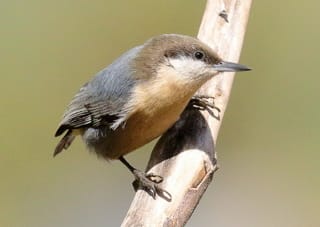 Photo: adult by Bob Walker 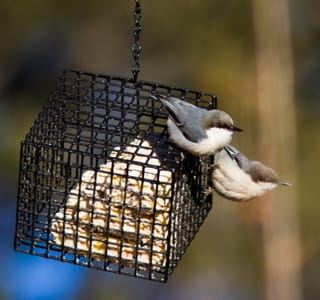 Photo: adult by Cullen Hanks 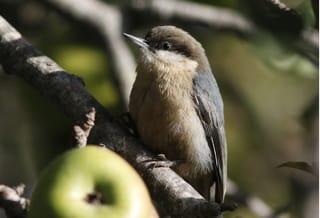 Photo: adult by Donna Pomeroy |  Pygmy NuthatchPYNU (Sitta pygmaea)Family: Sittidae (Nuthatches) Size: 3.8 - 4.5 in (10 - 11 cm) Flies: Jan 01 - Dec 31 Morphology: males and females are similar with slate gray wings and back, a brown cap, and white to buff underparts Status: native; common Food source: primarily insects such as beetles and true bugs in summer; a variety of seeds in winter, especially pine seeds Habitat: pine forests including ponderosa with undergrowth Pygmy Nuthatches are very gregarious, often wandering in noisy flocks and roosting communally. They are also acrobatic, using their sharp claws to help them hop upside down while foraging on the outermost and highest tree branches. These birds are easily attracted to feeders by sunflower seeds, nuts and suet. They often use bark crevices as a place to hold food while breaking it up with their bills. Pygmy Nuthatches nest in cavities in conifers lined with soft materials. A nesting pair may have helpers, usually offspring from a previous year, that aid in defending the territory and raising the young. Eggs are incubated for a little over 2 weeks and the young fledge about 3 weeks later. Info Photos Distribution Frequency |
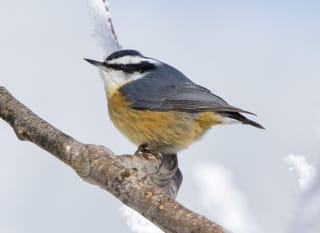 Photo: male by Mouser Williams 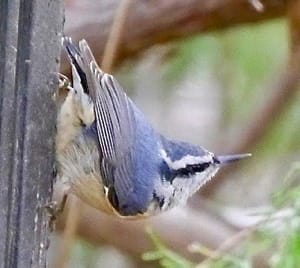 Photo: female by Judith Lopez Sikora |  Red-breasted Nuthatch, Canada NuthatchRBNU (Sitta canadensis)Family: Sittidae (Nuthatches) Size: 4.5 - 4.8 in (11 - 12 cm) Flies: Jan 01 - Dec 31 Morphology: both males and females are blue-gray in color with rusty-colored undersides and a black stripe through the eye; males have a black cap; females have a gray cap with lighter colored undersides Status: native; uncommon Food source: mainly insects and spiders in summer; seeds, often from conifers, in winter; young feed on insects Habitat: coniferous forests primarily in mountainous areas Red-breasted Nuthatches are quiet birds that prefer dense cover so that they are often missed. However, they can be attracted to feeders with sunflower seeds, peanut butter and suet. They can be seen in mixed-species flocks outside the breeding season. Like other nuthatches, these birds are gymnasts. They move rapidly up and down tree trunks and along the undersides of branches looking for food which they may then hoard in a larder. Nests consist of hollowed out cavities which the birds excavate themselves. They smear the entrance with pitch. It has been postulated that this is to deter other creatures. They avoid getting stuck themselves by flying straight into the hole. Incubation time for the eggs is about 12 days with the young leaving the nest 2 to 3 weeks later. Info Photos Distribution Frequency |
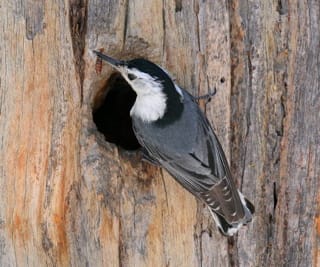 Photo: male by Bob Walker 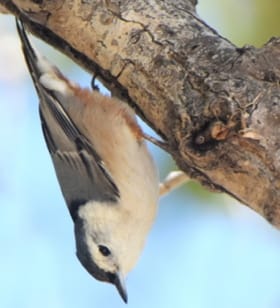 Photo: common foraging position by Steven Mlodinow 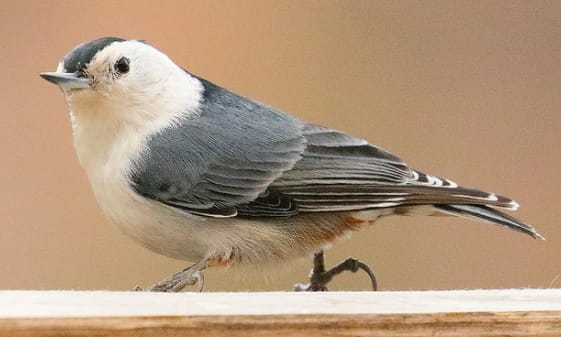 Photo: female by Bob Walker |  White-breasted NuthatchWBNU (Sitta carolinensis)Family: Sittidae (Nuthatches) Size: 5 - 6 in (13 - 15 cm) Flies: Jan 01 - Dec 31 Morphology: males have solid back cap with bluish-gray back and wings, white face and white underparts that may have some chestnut color; females are duller than males with a paler cap Status: native; common Food source: variety of insects and seeds Habitat: typically in mature deciduous forest but also in mixed conifer forests White-breasted Nuthatches are common throughout the year in most of the US with several subspecies officially recognized. They are often seen at suet feeders or creeping along tree trunks with their heads down looking for insects in bark crevices. These nuthatches are typically seen singly or in pairs. However, in fall and winter, they will join small mixed-species flocks. Pairs may mate for life and remain in the same area all year round. Nests are built in a cavity from bark fibers, grasses and other materials. Eggs hatch in about two weeks and fledge anywhere from three to four weeks later. Info Photos Distribution Frequency Featured |
